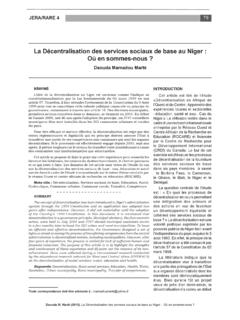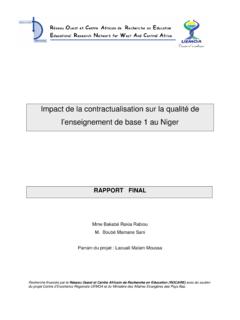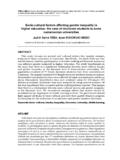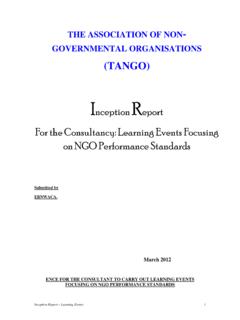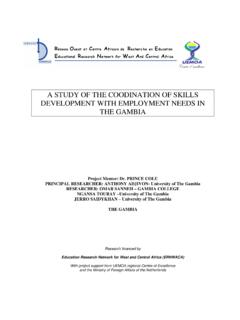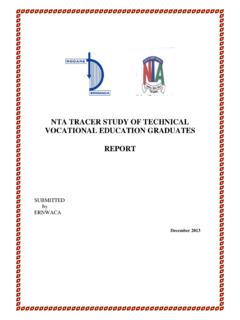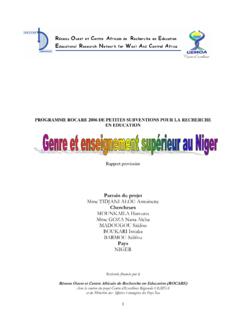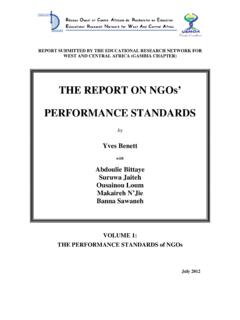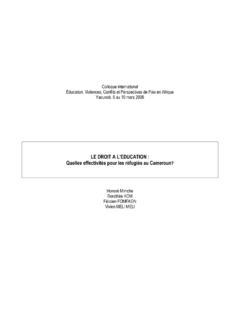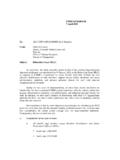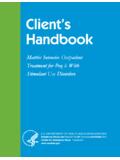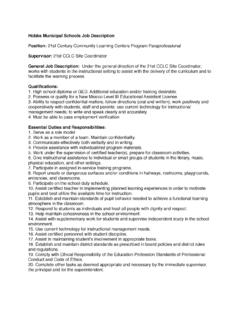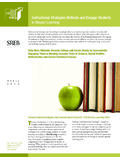Transcription of AN EVALUATION OF THE IMPACT OF INTERNET BROWSING …
1 R seau Ouest et Centre A fricain de Recherche en Education Educational Research Network for West A nd Central A frica AN EVALUATION OF THE IMPACT OF INTERNET . BROWSING ON STUDENTS' ACADEMIC PERFORMANCE. AT THE TERTIARY LEVEL OF EDUCATION IN NIGERIA. O. Osunade (Principal Researcher). Department of Computer Science University of Ibadan Ibadan, Nigeria Research financed by the Educational Research network for West and Central Africa (ERNWACA). with support from the International Development Research Center (IDRC) in Canada and the Academy for Educational Development (AED) in USA. And USAID - Washington February 2003. ROCARE / ERNWACA Tel: (223) 221 16 12 / 674 83 84, Fax: (223) 221 21 15 BP E 1854, Bamako, MALI B nin Burkina Faso Cameroun C te d'Ivoire Gambia Ghana Guin e Mali Nigeria S n gal Sierra Leon Togo Summary (max 3 pages).
2 The research work evaluated the INTERNET as a knowledge acquisition tool and its IMPACT on academic performance of students selected from five science-based courses (Mathematics, Physics, Computer Science, Civil and Mechanical Engineering). The study used two tertiary institutions in Oyo State, Nigeria. The summary of the results obtained are: 1. There is a significant difference in the results of students with INTERNET access and those without INTERNET access. 2. There was a significant improvement in the posttest scores of the test group. 3. There were more male participants than female participants. 4. Students use the INTERNET an average of two / three days per week. 5. The male participants prefer night BROWSING , while the female participants prefer the daytime. 6. Most of the participants started using the INTERNET in year 2001.
3 7. The male participants were generally older than the female. 8. Electronic mail (email) is the most popular use of the INTERNET among students. 9. Almost all students have used the INTERNET before. 10. About 60% of students are in the 21-25 age bracket. Acknowledgement Our special thanks to the project advisor, Professor Joseph O. Odeyemi, for his interest in the research work and support in getting cooperation from the universities involved. We are grateful to Dr Dayo Odukoya for his dedication to the survival of the ERNWACA. Nigeria group and his unqualified advice and support towards the production of a useful and viable research report. The Lord will bless the work of your hand and your family. The contribution of the Registrars' and Head of Departments at the University of Ibadan, Ibadan and Ladoke Akintola University of Technology, Ogbomoso is hereby acknowledged.
4 We thank you for giving us access to the students. Thanks also go to the data entry operators, Tolu and Posi, who had to work twice because of a change in methodology. Thanks to the Department of Computer Science for their contribution in kind to the study. To every student who participated in the study we are grateful. Table of Content Summary of 03. Acknowledgement .. 03. Content .. 04. 05. Literature 07. Statement of 10. Significance of 11. 11. Methodology .. 12. Research 12. Sample and Sampling Technique .. 12. Research 12. Activities and Procedure for Data 12. Collation and Treatment of 12. Analysis of 14. 27. 28. 29. Appendix .. 31. Registration form .. Introduction The INTERNET is a global network of computers linked together over large distances. It was created by the American Military as a means of communication and has been in existence since the 1950's.
5 Up until the mid to late eighties commercial organizations and educational institutions mainly used the INTERNET . This was due to high costs. The rapid development of technology has seen improvement in communication links and a lowering of costs. The implication of this is that the INTERNET is now more widely available to more people. Since the INTERNET is now available to a wide sector of the population in the western world many educational establishments have seized on its educational potential. The INTERNET is a valuable source of information for students looking for ideas for projects and assignments. With over 50 million web sites on the net the chances are any information however obscure can be found. The only tools required to find this information would be some patience and a decent search engine.
6 It also serves as a useful tool for lecturers in helping to prepare lesson plans as there are a number of sites, especially in America, dedicated to providing educational material. It also serves as a forum to promote group discussion, which is time and distance independent. There are many forms this group discussion can take. These include video conferencing, where by the use of a small video camera and microphone members of the group can actually see and hear each other. Also group discussion can take the form of chat rooms where everyone comes together in a host area and communicates with each other via the keyboard. Although there may be many advantages to be gained from using the INTERNET as an educational tool there are also many drawbacks. For first time users the INTERNET can be a very unfriendly environment but with frequent use users can get familiar with pretty quickly.
7 The amount of information available on the net means that user tend to be side-tracked with a lot of unnecessary useless information. As the INTERNET is not owned by any one there are no checks or censorship of information available. The upside to this is that information is freely available to everyone with out restriction but the downside to this is that information can be placed into the wrong hands. Also as there are no checks on the information on the net this may lead to inaccuracies and misleading information being published. The INTERNET is heavily dependent on hardware which can be expensive especially as the INTERNET is constantly evolving. This therefore means to take full advantage of this evolving technology; upgrades in hardware and software are required. With the advent of the INTERNET education has definitely benefited in more ways than can be mentioned and although it will not take over the traditional methods of education it will continue to play a major part.
8 University of Ibadan started off as a college of the University of London University College of Ibadan. It admitted its first set of students in 1948. The 32-year old Faculty of Technology is devoted to the advancement and application of knowledge through teaching/learning, research and scholarship, in Agricultural Engineering, Civil Engineering, Electrical and Electronic Engineering, Food Technology, Industrial and Production Engineering, Mechanical Engineering, Petroleum Engineering and Wood products Engineering. The Faculty of Science was one of the three Foundation Faculties at the inception of the University of Ibadan in 1948. The Faculty expanded steadily from its initial six departments An EVALUATION of the IMPACT of INTERNET Ernwaga 2002 Small Grant Project Page 5. of Botany, Chemistry, Geography, Mathematics, Physics and Zoology.
9 The Faculty now consists of ten departments of Archeaology and Anthropology, Botany and Microbiology, Chemistry, Computer Science, Geography, Geology, Mathematics, Physics, Statistics and Zoology. Ladoke Akintola University of Technology, Ogbomoso was established in the year 1990. Tha Faculty of Pure and Applied Sciences which is one of the four foundation Faculties with which the University took off in 1990 comprises of five Departments: Departments of Pure and Applied Biology, Pure and Applied Chemistry, Pure and Applied Mathematics, Pure and Applied Physics and General Studies. The Faculty of Engineering and Technology is also a foundation faculty and comprises of departments like Computer Science and Engineering, Civil Engineering, Mechanical Engineering, Food Technology and Engineering, and Electrical and Electronics Engineering.
10 An EVALUATION of the IMPACT of INTERNET Ernwaga 2002 Small Grant Project Page 6. Literature Review Technology, in various forms, has always held forth the promise of improving education (Wenger, 1998). This is true whether one speaks of scholastic education or its cousins, corporate and commercial training programs. Computer-Assisted Instruction (CAI), instructional television (ITV), and programmed instruction (PI) can be counted as early examples of the application of information technology to education. The most recent and perhaps most visible cases are Web-based training programs and degree-granting programs from fully accredited institutions offered via what is known as "distance learning.". Technology succeeds, when it becomes commonplace. This is amply illustrated by such mundane and ubiquitous artifacts as chalkboards, training films and videos, overhead projectors and transparencies, software such as Microsoft's PowerPoint, and perhaps the most common of all, the textbook.
